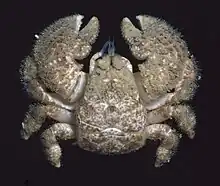Hairy stone crab
The hairy stone crab (Lomis hirta) is a crab-like anomuran crustacean that lives in the littoral zone of southern Australia from Bunbury, Western Australia, to the Bass Strait.[2] It is the only species in the family Lomisidae. It is 1.5–2.5 cm (0.6–1.0 in) wide,[2] slow-moving, and covered in brown hair which camouflages it against the rocks upon which it lives.[3]
| Hairy stone crab | |
|---|---|
 | |
 | |
| Scientific classification | |
| Domain: | Eukaryota |
| Kingdom: | Animalia |
| Phylum: | Arthropoda |
| Class: | Malacostraca |
| Order: | Decapoda |
| Suborder: | Pleocyemata |
| Infraorder: | Anomura |
| Superfamily: | Lomisoidea Bouvier, 1895 |
| Family: | Lomisidae Bouvier, 1895 [Note 1] |
| Genus: | Lomis H. Milne Edwards, 1837 |
| Species: | L. hirta |
| Binomial name | |
| Lomis hirta (Lamarck, 1818) | |

Live specimen
Some controversy exists about the relationship between L. hirta and the other anomuran families. Candidates for its closest relatives have included hermit crabs,[4] specifically king crabs,[5] and Aegla.[6][7] It is clear, however, that Lomis represents a separate case of carcinisation.[8]
Notes
- The name "Lomidae" may also be encountered, but is incorrect.[1]
References
- McLaughlin, Patsy A.; Komai, Tomoyuki; Lemaitre, Rafael; Rahayu, Dwi Listyo (2010). Low, Martyn E. Y.; Tan, S. H. (eds.). "Annotated checklist of anomuran decapod crustaceans of the world (exclusive of the Kiwaoidea and families Chirostylidae and Galatheidae of the Galatheoidea) Part I – Lithodoidea, Lomisoidea and Paguroidea" (PDF). Zootaxa. Suppl. 23: 5–107. Archived from the original (PDF) on 2012-03-02.
- Davey, Keith. "Species bank: Lomis hirta". Department of the Environment and Heritage. Retrieved August 15, 2006.
- "Hairy Stone Crab". Museum Victoria. 1996. Archived from the original on 2006-04-11. Retrieved 2006-08-15.
- Dixon, C. J.; Schram, F. R.; Ahyong, S. T. (2004). "A new hypothesis of decapod phylogeny". Crustaceana. 76 (8): 935–975. doi:10.1163/156854003771997846.
- Martin, J. W.; Abele, L. G. (1986). "Phylogenetic relationships of the genus Aegla (Decapoda: Anomura: Aeglidae), with comments on anomuran phylogeny". Journal of Crustacean Biology. The Crustacean Society. 6 (3): 576–616. doi:10.2307/1548195. JSTOR 1548195.
- Morrison, C. L.; Harvey, A. W.; Lavery, S.; Tieu, K.; Huang, Y.; Cunningham, C. W. (2001). "Mitochondrial gene rearrangements confirm the parallel evolution of the crab-like form" (PDF). Proceedings of the Royal Society of London B. 269 (1489): 345–350. doi:10.1098/rspb.2001.1886. PMC 1690904. PMID 11886621.
- Porter, Megan L.; Pérez-Losada, Marcos; Crandall, Keith A. (2005). "Model-based multi-locus estimation of decapod phylogeny and divergence times". Molecular Phylogenetics and Evolution. 37 (2): 355–369. doi:10.1016/j.ympev.2005.06.021. PMID 16112880.
- Keiler, Jonas; Richter, Stefan; Wirkner, Christian S. (2016). "Revealing their innermost secrets: an evolutionary perspective on the disparity of the organ systems in anomuran crabs (Crustacea: Decapoda: Anomura)". Contributions to Zoology. 85 (4): 361–386. Archived from the original on 2017-01-18. Retrieved 2016-11-17.
This article is issued from Wikipedia. The text is licensed under Creative Commons - Attribution - Sharealike. Additional terms may apply for the media files.